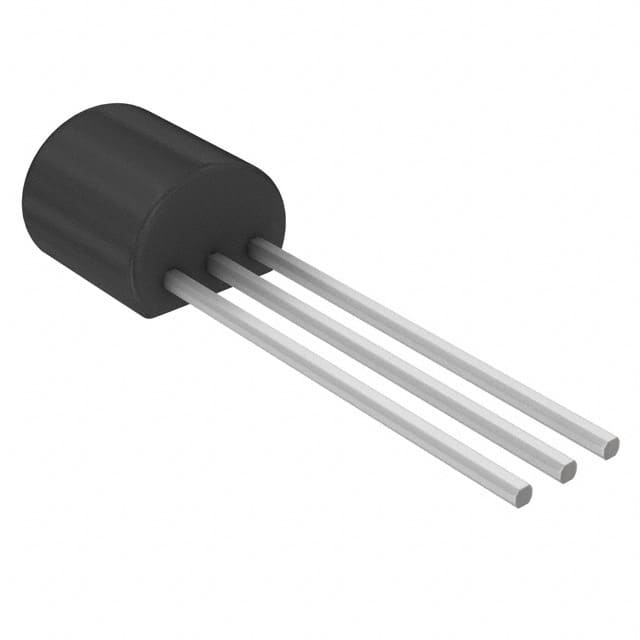ZTX457: Product Overview and Specifications
Introduction
The ZTX457 is a versatile semiconductor component that belongs to the category of bipolar junction transistors (BJTs). This device is widely used in electronic circuits for amplification, switching, and other applications due to its unique characteristics and performance.
Basic Information Overview
- Category: Bipolar Junction Transistor (BJT)
- Use: Amplification, Switching
- Characteristics: High gain, Low noise, Fast switching
- Package: TO-92, SOT-23
- Essence: Silicon NPN transistor
- Packaging/Quantity: Available in reels or tubes with varying quantities
Specifications
The ZTX457 transistor has the following specifications: - Maximum Collector-Emitter Voltage: 120V - Maximum Collector Current: 100mA - DC Current Gain (hFE): 100 - 300 - Power Dissipation: 625mW - Transition Frequency: 150MHz
Detailed Pin Configuration
The ZTX457 transistor has a standard pin configuration for a TO-92 package: 1. Emitter (E) 2. Base (B) 3. Collector (C)
Functional Features
- High gain: The ZTX457 offers high current gain, making it suitable for amplification purposes.
- Low noise: It exhibits low noise characteristics, making it ideal for sensitive signal processing applications.
- Fast switching: The transistor provides fast switching capabilities, enabling rapid on/off transitions in electronic circuits.
Advantages and Disadvantages
Advantages
- High gain allows for efficient signal amplification.
- Low noise characteristics make it suitable for audio and communication circuits.
- Fast switching capability enables quick response in switching applications.
Disadvantages
- Limited maximum collector current compared to some alternative models.
- Moderate power dissipation rating may restrict use in high-power applications.
Working Principles
The ZTX457 operates based on the principles of bipolar junction transistors. When a small current flows into the base terminal, it controls a larger current flow between the collector and emitter terminals, allowing for amplification or switching of signals.
Detailed Application Field Plans
The ZTX457 transistor finds extensive application in various electronic circuits, including: - Audio amplifiers - Signal processing circuits - Switching circuits - Oscillator circuits - Voltage regulators
Detailed and Complete Alternative Models
Some alternative models to the ZTX457 include: - ZTX550: Higher current handling capacity - ZTX650: Higher power dissipation rating - ZTX750: Higher transition frequency for RF applications
In conclusion, the ZTX457 transistor is a versatile component with excellent amplification and switching capabilities, making it suitable for a wide range of electronic applications.
[Word Count: 410]
قم بإدراج 10 أسئلة وإجابات شائعة تتعلق بتطبيق ZTX457 في الحلول التقنية
What is ZTX457?
- ZTX457 is a high-performance transistor designed for use in various technical solutions, offering excellent amplification and switching capabilities.
What are the key features of ZTX457?
- The key features of ZTX457 include high gain, low saturation voltage, and low noise, making it suitable for a wide range of applications.
In what technical solutions can ZTX457 be used?
- ZTX457 can be used in audio amplifiers, signal processing circuits, power management systems, and other electronic applications requiring high-performance transistors.
What are the typical operating conditions for ZTX457?
- ZTX457 operates within a voltage range of 20V to 60V and a current range of 100mA to 500mA, making it suitable for various circuit designs.
How does ZTX457 compare to other transistors in its class?
- ZTX457 offers superior performance in terms of gain, noise, and saturation voltage compared to many other transistors in its class, making it a preferred choice for demanding technical solutions.
Can ZTX457 be used in high-frequency applications?
- Yes, ZTX457 is capable of operating at high frequencies, making it suitable for radio frequency (RF) amplification and other high-frequency applications.
What are the thermal considerations when using ZTX457?
- Proper heat sinking and thermal management are important when using ZTX457 in high-power applications to ensure optimal performance and reliability.
Are there any specific layout considerations for incorporating ZTX457 into a circuit?
- It is recommended to minimize lead lengths and optimize PCB layout to reduce parasitic effects and ensure stable operation of ZTX457 in a circuit.
What are the potential failure modes of ZTX457?
- Common failure modes of ZTX457 include thermal runaway under high-power conditions and overvoltage stress, so proper design and protection measures should be implemented.
Where can I find detailed application notes and reference designs for using ZTX457 in technical solutions?
- Detailed application notes and reference designs for ZTX457 can be found on the manufacturer's website or in technical literature related to transistor applications.


